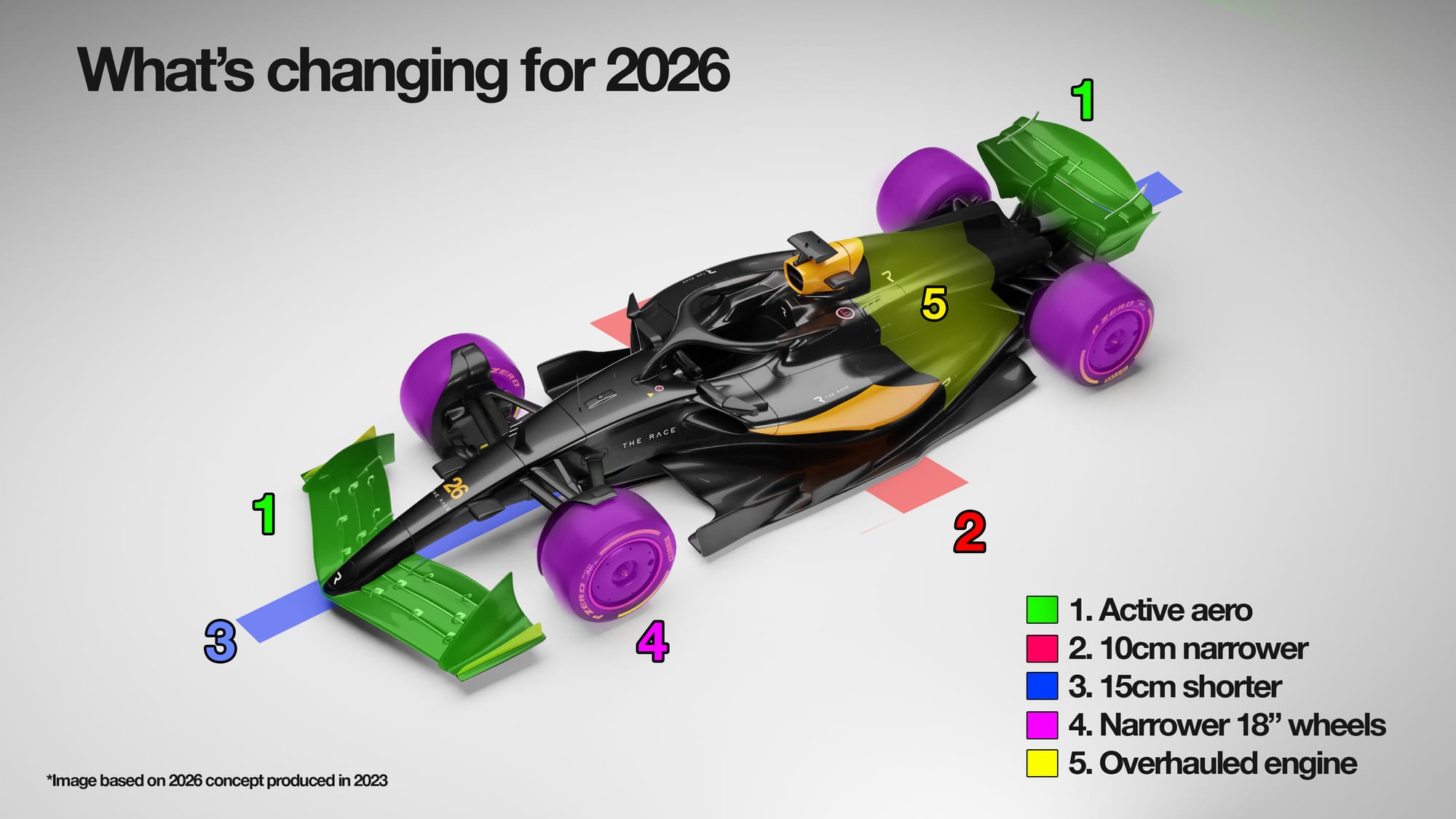The world of Formula 1 is bracing for a seismic shift, a technical revolution so profound that it promises to tear up the form book and redefine the very essence of grand prix racing. The year 2026 is not just another season on the calendar; it is a hard reset, a daring leap into the unknown with a new generation of cars designed to be smarter, more sustainable, and, crucially, more competitive. But with this great leap comes great uncertainty. The radical new power units and revolutionary aerodynamic concepts could shuffle the grid in ways not seen for decades, potentially toppling dominant dynasties and elevating dark horses into championship contenders.

At the heart of this transformation lies the power unit. While the 1.6-liter V6 turbo engine remains, it has been fundamentally reimagined. The most significant and complex component, the Motor Generator Unit-Heat (MGU-H), is being completely removed. This expensive and intricate piece of technology, which recovers energy from the turbocharger, has long been a barrier to new engine manufacturers. Its elimination is a deliberate move to simplify the power unit and attract new automotive giants like Audi and Ford back into the sport, a goal the FIA has successfully achieved.
However, this simplification comes with a radical new philosophy. For the first time, the power output will be split almost evenly, a near 50/50 division between the internal combustion engine and the electrical systems. The MGU-Kinetic (MGU-K), which recovers energy under braking, will see its power contribution triple, providing a staggering 350 kilowatts of electrical energy. This shift fundamentally alters the DNA of an F1 car, moving it from a machine that is merely assisted by hybrid technology to one that is deeply dependent on it.
This dependency creates a thrilling and terrifying new challenge. One of the biggest concerns voiced by engineers and drivers alike is the potential for cars to effectively “run out” of electrical energy on long straights. Under the new regulations, the massive electrical deployment will deplete rapidly, and if a driver cannot harvest enough energy through the preceding corners, they could find their car hitting a virtual wall, suddenly losing speed as the electrical boost cuts out. This prospect introduces a level of strategic depth and driver skill that will be paramount. Races could be won or lost not just by pure speed, but by the intelligence and finesse with which a driver manages their energy reserves.

To counter this potential power deficit and fundamentally change the nature of on-track battles, the FIA has introduced another game-changing element: a “manual override mode.” This system, which some are calling a “push-to-pass,” will allow drivers to deploy their full electrical power for a short burst, giving them a significant speed advantage to attack or defend. This driver-activated boost will replace the Drag Reduction System (DRS), which has been a staple of modern F1 but has often been criticized for creating predictable, “push-button” overtakes. The new override mode promises more organic and thrilling wheel-to-wheel combat, forcing drivers to think like chess masters, deciding the perfect moment to deploy their most powerful weapon.
The revolution doesn’t stop at the engine. The 2026 cars will look and behave differently, thanks to a complete overhaul of the aerodynamic regulations. The new formula calls for cars that are smaller, nimbler, and significantly less reliant on generating massive amounts of downforce through complex bodywork. The goal is to reduce the “dirty air” that trails a car, a turbulent wake that makes it incredibly difficult for a following car to get close enough to overtake. The regulations aim to slash downforce by around 30% and, even more dramatically, reduce drag by a staggering 55%.
To achieve this, Formula 1 is embracing a technology it has long resisted: active aerodynamics. For 2026, both the front and rear wings will be movable. Cars will feature two distinct modes: a high-downforce “cornering mode” and a low-drag “straight-line mode.” As a car blasts down a straight, the wing elements will flatten out, dramatically reducing air resistance and increasing top speed. As it approaches a braking zone, the wings will snap back into their high-downforce configuration, providing the grip needed to navigate the corner. This dynamic system, while fascinating from a technical standpoint, also adds another layer of complexity for drivers to manage and for fans to understand.
The feedback from the simulator has been mixed. Drivers have reported a noticeable lack of grip in corners, describing cars that feel nervous and on a knife’s edge. This is by design. The intent is to place a greater emphasis on driver skill, rewarding those who can master a less forgiving machine. The challenge of harvesting the required 8.5 megajoules of energy per lap while simultaneously managing the active aero systems and planning strategic use of the override mode will be a monumental test of mental fortitude.

So, who stands to win this high-stakes technological gamble? The truth is, nobody knows for certain, which is precisely what makes the prospect of 2026 so exhilarating. Red Bull, the current dominant force, will face the challenge of developing its very first power unit in-house through its new Red Bull Powertrains division, a massive undertaking even for a team of its caliber. Mercedes, who mastered the last major engine regulation change in 2014, will be confident they can repeat their success. Ferrari, with its immense resources and history, can never be counted out.
Yet, many eyes are on a dark horse: Aston Martin. Their new partnership with Honda, the manufacturer that powered Red Bull to its recent string of championships, is seen as a masterstroke. With a new state-of-the-art factory and a hunger to win, the Silverstone-based team is positioning itself to be a major contender.
The initial phase of the 2026 season is likely to be a chaotic and fascinating period of discovery. Reliability will be a huge factor, much like in 2014 when some teams struggled just to complete a lap in pre-season testing. We can expect to see a wide variety of car designs and concepts as teams interpret the new rules in different ways before eventually converging on the most effective solutions. For the fans, this means unpredictability, the thrill of seeing an underdog on the podium, and the dawn of a new, fiercely competitive era in the pinnacle of motorsport. The great reset is coming, and with it, the promise of a spectacular new chapter for Formula 1.
News
Lewis Hamilton’s stunning performance at the Monza GP left Ferrari utterly speechless. The British driver delivered an unexpected result that has raised eyebrows in the paddock. Ferrari, caught off guard, could hardly believe what they were witnessing. Was this a turning point in the season?
Ferrari’s Unexpected Revival: How Lewis Hamilton is Turning the SF25 into a Championship Contender The paddock at Ferrari has been…
Monza Drama Unfolds: Ferrari’s Stunning Response to the Tow Controversy As the Monza drama continues to make waves, Ferrari has issued a statement that could shift the narrative entirely. The tow controversy has left many wondering what really happened during the race. Ferrari’s response raises more questions than answers, but it’s certainly a game-changer.
F1 Italian Grand Prix: Max Verstappen’s Stunning Pole, McLaren’s Challenge, and Ferrari’s Tough Decisions The 2025 Italian Grand Prix has…
“Monza Chaos: Piastri’s Rule Breach Leads to Unexpected Verdict!” In a stunning twist after the Monza race, Piastri has received a new verdict following his controversial breach of rules. Fans are left questioning the future of this young driver!
Formula 1 Italian Grand Prix: Updates from Friday Practice at Monza The Italian Grand Prix at Monza always promises high-speed…
Ferrari’s Dirty Laundry Exposed: Fred Vasseur Blames Sabotage for Hamilton’s Trouble at the Dutch GP – What Does This Mean for Ferrari’s Reputation and Their Chances in the 2025 Championship?
The Sabotage Scandal: Ferrari’s Darkest Moment Since the Dutch GP After the chaos of the Dutch Grand Prix, the silence…
“The 2025 Italian GP: A Rollercoaster of Emotions – Winners, Losers, and the Moments You Can’t Miss!” Monza’s 2025 Grand Prix proved to be one of the most dramatic in recent years. As the season heats up, which drivers and teams celebrated their triumphs, and who was left reeling from devastating setbacks? Click now to see how the race unfolded with stunning victories and heartbreaking losses.
Monza 2025: The Thrills, Chaos, and Drama of the Italian Grand Prix The 2025 Formula 1 season has been nothing…
“Revealed: How Hamilton’s Telemetry is Set to Revolutionise Ferrari’s Monza Strategy!” Ferrari’s engineers have found something extraordinary in Hamilton’s telemetry data after qualifying at Monza. This revelation could drastically alter the team’s strategy and performance at the Italian Grand Prix. With crucial insights from Hamilton’s data, Ferrari might just have what they need to make a strong push for victory.
Ferrari’s Rebirth: Hamilton’s Monza Masterclass Monza is a track where speed, precision, and strategy come together to create some of…
End of content
No more pages to load












